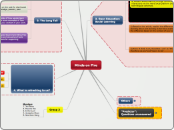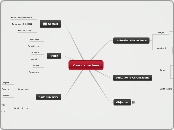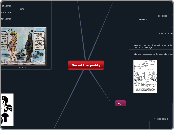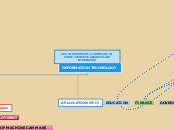Laura,
I agree. Using a simulation for medical school, as an example, would be a good start for gross anatomy. But a student need to feel the cut of the knife and how much pressure to use. If all they everhad was a simulation they will never know how much pressure it takes to cut through the skin.
As you mentioned sith the simulations, you cannot make mistakes. Most of the time in life we learn more from our mistakes than from doing it correct the first time.
Todd
With no doubt I agree with you ladies that teachers can be very creative and create their own quizzes and experiences to go with simulations that are available to everyone with access to the internet. I was very impressed with the frog simulations that we explored this past week. It's amazing what the internet has to offer us as teachers. These resources can come in very handy when trying to create a more one on one experince for all students.
I think that you brought up a good point Monique. I agree that it can sometimes seem unfair that the schools who don't have the money can't afford the full effect of the online simulation. However, if a school can't afford the real one either than the students are missing out completely. If they are able to take advantage of the minimal amount of free resources for such dissections online I say go for it. A thrifty teacher can come up with their own quizes based on the information provided and they can also find ways to get creative with the amount of things the resources are giving them. While the ideal situation would be to have all of the simulation web access, little access is better than no experience at all.
I also agree with Ann that schools can get creative on finding grants to help support them or, as I mentioned before, they may be able to find ways to simply use what minimal material they are given!
Simulated vs. Actual Frogs
Group Discussion: Simulated vs. Actual Frogs
One of the standard activities of high school biology is the frog dissection. This activity has endured for many decades and dissections of this sort are considered to be absolutely central to learning what science is all about. With the advent of computer simulations, teachers now have a choice of doing actual and/or simulated dissections.
In this discussion, you are to consider the pros and cons of simulated frog dissections.
Before starting, you need to try a few simulated frog dissections. Here are three suggestions.
Froguts. Select the frog dissection demonstration and complete it in its entirety (5-10 minutes).
The "Froggy" Project from the Lawrence Berkeley National Lab for an example of an actual virtual dissection. Spend time exploring the "Virtual Frog Dissection Kit" as well as some of the other resources and information. (5-10 minutes)
"Net Frog" from the University of Virginia. This is another virtual dissection website. It requires a fast Internet connection because it has audio and video clips. Also, it is a bit more graphic (dissections by their nature are graphic) and you may not want to explore this site while eating lunch. (15 minutes)
After you have explored the virtual learning expeiences, you may enter the discussion. Please focus the discussion on the following question:
What important aspect of a good science education is gained or lost in doing simulated, rather than an actual, frog dissections?
The purpose of this discussion is to get you to consider more carefully the nature of learning experiences. In particular, we say we prefer "hands-on" or "real" experience, but we are too often quite inarticulate about exactly what it is about these kinds of experiences that makes them compelling. What do we mean by "real" or "hands-on" and why are they important to learning. Hopefully, this discussion will encourage you to become more sophisticated in your understanding of this issue.
I can see how it would be beneficial for students to maybe view the simulation dissection together as a whole group(Smartboard) to introduce the procedures of dissecting a frog first, so the students have a clearer idea of how to dissect before they participate in a "live" dissection themselves. Maybe this would help reduce anxiety that students may have before dissecting. I also feel that having access to the simulation would be great for students in that they can return to the site to review and revisit concepts as often or little as needed before they are assessed on the objectives.
What an awesome idea to project it onto a smartboard or a projector screen (which I just received in my classroom
:-)) as a whole group. This would be a great way to model what steps the students will be taking on their own. I don't see why it wouldn't be a good idea for students to have access to the simulation. You could also debrief as a whole group after the students do the simulation on their own what things in particular went well and those that didn't go so well.
Ann, I never thought about using the smart board or perhaps any form of projecting to demonstrate how to do the dissection using the simulation. I think that is a really great idea because it allows students to see what is expected of them versus telling them how something should be done. Things can go very wrong with a small misinterpretation and this is less likely to occur if students are able to see the full dissection ahead of time in a whole group setting.
I also thought about this in reference to my inquiry prject. I teach first grade and much of our computer time learning is done in a whole group setting with me using an S-video cord to hook the computer up to the television. I had already planned on this to demonstrate to my students how to do the simulation we will be using. I never thought about taking it farther to use with older children to introduce them to topics as well.
Great idea!
In doing the simulations online, I found it very exciting that these are availbe online. I took Anatomny in highschool, and we had to do the frog experience, as well as cats. I grew up in an area where the schools never had a lack of money to allow us to have hands on experiences in the classroom. Since becoming a teacher, I have seen school districts where this type of hands on activity would not be possible. With that being said, these types of simulations that are offered online are allowing students to share in the experience that they would otherwise be missing out on. I think we can all agree that hands on is definitely a better way for students to get a full understanding of any type of assignment, but would it better for the students to miss out completely or to at least have an opportunity to experience the activity in a different way?
Simulations seem to offer students a chance experience things that they may not have done had it been a hands on activity. It also allows students to work one on one with the program at their own pace and to still participate in the activity. Thinking back to the same activities I mentioned in highschool, I did not enjoy the activities becuase I felt too close to the things we were disecting. I think I may have gotten more out of it if I was able to sit through a simulation. Also, it gives you a chance to redo things and to listen to different parts. I really liked that during the frog simulation I did online. It gave you a detailed description of every little thing that you were doing as you did it. Students all work at different paces and it allowed them to still get as much out of the simultaion as possible while being able to complete the activitiy. I also thought it was nice that they offered a quiz at the end. Although I just used the trial version and was unable to see it, I imagine it would be a decent quiz based on the types of informaton that the proram had packed into the simulation. Overall, I think that simulated activities are in a way better because they can offer experiences to students who may not have been able to participate due to lack of funding or ability. It also allows students to work at their own pace and still get the same information.
I agree with your stance Laura about the fact that simulations can offer students experiences that they might not have if the schools can't provide real dissections because of not having the funds available. It's important that all students experience dissections as they learn about the anatomy, tools to dissect, and what the functions of the parts of the living organism are. I remember three dissections in K-12, a cow eye, a frog, and an owl pellet. In the school I work at, my 3rd graders dissect a owl pellet and a cow eye. Therefore, they have had almost all of the dissecting experiences I had in K-12 already in third grade. Students whose schools can't provide their students with these "real" dissections should consider looking into simulations. It's important that all students experience dissections at some level.
Simulations offer a one on one experience for the student and the computer program, and allow students to go back and try dissections over and over. This can't happen in a "real" dissection. The amount information available on some simulation sites offer students a great resource for reviewing and learning content specific matter. Students will want to read and re-read the information because they are in control of the mouse, and they are on the computer which is a tool that they associate with FUN!
I have not seen anywhere that talked about this idea, but I was wondering if there is a way for you to have classes partner up via an online simulation. Perhaps you could have one class in one school be "lab partners" with students in another school ( probably in the same district due to curriculum differences among districts). You could not only incorporate the technology via the simulated online dissection, but you could also incorporate a discussion amongst students from other areas. It might spark some questions and ideas having students with different environments working together.
I think that would be a great idea Laura! The first Web 2.0 application I thought about was VoiceThread. They could unpload a image of a frog and students from different classes could add comments around the frog and discuss what they learned in the dissections, or even discuss the parts of the frog right there around the frog image, which could be also be a video, or a document.
Monique, I think that would be a great way of using Voicethread. Just think of the extended learning that would take place when the students can share and dialogue about their new learnings!
I think that the online dissection would be a great way to allow students another opportunity to work on areas they may be having difficulty in. You could do this in one of two ways:
1.) Have the entire dissection be a simulated one. This would be less messy ( as I mentioned in another post) than an actual dissection. You could also pinpoint areas that the student may need to revisit, and they could go right back to that portion of the dissection online without having any problems. Also, students have different areas that they need to work on and the individual computer simulated dissections would allow for that. I know that students have their own actual frogs too usually, but it can get confusing when each group is on a different portion. This way the computer can help to guide them. It allows for differentiation, which any teacher knows is a must within the classroom.
2.) Have the dissection be an actual one, and use the simulated dissection for reenforcement for those students who are struggling.
AnnWilliams
I am wondering how important is it for students to do an actual "hands on" dissection as opposed to a simulation dissection? I look back of when I did live dissections and I don't feel that it was an experience that was a "Must Have" in regard to my profession today. I think for students that are going to go into the medical field or the biological science field the actual "hands on" dissection would be very important. Is there a way to gear our science courses so that the students that need the actual "hands on" experiences are grouped in a class that provide live dissection, and all other students are placed in science courses where they learn the basics through simulation instruction?
I am thinking that for some students, they might learn the concepts better through simulation where they don't have to worry about the awful smell, the goryness of real dissection, and fear that they might not make the appropriate cuts. I personally think I might have enjoyed it more and understood things better if I had the opportunity to learn through a simulation of a dissection.
I definitely agree with you Ann when you discussed the fact that some students might learn better with the simulation because they can focus more on the content they are learning and not the smell and goriness of dissecting a animal if they have a sensitivity to those things or even a ASD sensory problem. I do think "hands on experiences" are crucial for students, however if students have sensory issues they would benefit more from a simulation experience. The simulation will offer students a close to hands on experience.
Two of the three simulations we explored have a cost assocaited with them if you want to have acess to their entire site. Just wondering how this would help the schools who already don't have the funds available for real dissections. The free simulations are a great resource for teachers to use!
I thought of that concern as well, but then the idea that popped into my head was grant money. These schools need to get creative in how they acquire funds for new technology. They need to search and find grants that provide money for new technology integration.
Monique Wilson
This was my first virtual simulated experience. Each of the simulations offered similar ways to virtually dissect or put together a frog’s anatomy. However, each simulation was very different as well. The first simulation centered heavily on the dissection itself with some content knowledge on the frogs body parts while dissecting it. The second simulation was very basic in graphic terms. The other two simulations showed a real or close to real frog. However, it still offered a great experience for students to learn the parts of a frogs insides. The last simulation was very involved. It had a lot of content knowledge, glossary, and guess what questions, and watching the real dissections occur was interesting, and somewhat unsettling on the stomach:-)
After visiting, and actually doing the simulations myself, I feel like depending on the simulation, it can be very educational and offer a somewhat "hands on" experience of dissecting a living organism. As Laura mentioned, there's something to be said when you can actually touch the frog or whatever living organism your dissecting. When you’re doing a simulation, you are only using two of your senses see, and hear. When you are doing a real dissection, you are using all your senses except for taste. I think students get a more "real" life experience when they can use most of their senses. A real dissection experience will leave a lasting impression on students for their whole life.
Ann Williams
This was my first exposure to any kind of learning simulation like that. I found it exciting to explore the three different frog dissections. I definitely was able to select pros and cons among these three simulations. I liked Froguts graphics the best, and liked how it provided both text and an audio of the new information. It was very realistic. I also liked the way the Net Frog graphics showed the frog in the dissecting pan, and showed both a preserved and pithed frog. I didn't like how in the "Try it" section it has you click where you should cut, but doesn't show the actual cutting like in the Froguts simulation. One thing I like better about Net Frog, was how it showed the organs labeled during the teaching slides. I didn't care for "The Froggy Project" at all. However, if it came down to free resource as to one you have to pay for, it would be O.K. as a supplement to the classroom curriculum. If you could combine the best of Froguts and Net Frog you would have a totally awesome resource. I personally really liked the audio feature in Frog Guts. Net Frog did provide a video option that you could choose, which was helpful too.
Both provide a built in quiz that the student can take to check for understanding for immediate feedback.
It has been along time since I did a dissection in science class and I remember how bad the smell of the formaldahyde bothered me. Other than the smell, I always thought it was very fascinating to examine the real live body parts of an animal. I do remember worrying about whether I was going to cut things the way I was suppose to or was I going to cut through into something else and screw it up.
Being able to provide students with this type of learning experience would definitely be a plus. Probably the most ideal situation is one where they could have exposure to both "hands on" and virtual dissection experiences.
Laura Stokes
I think that the actual frogs might offer students more in a hands on way. They will get the science experience of actually physically working with the frogs. Students will also get the chance to make their own mistakes, which can sometimes be the best thing to help kids learn. Unfortunately, when you are using a scalpel, a mistake can be costly and you can't always go back and fix it, but you can see why it was a mistake and what you did wrong.
For me personally, sometimes the best way to learn was through mistakes.
With the simulated dissection, in my experience with it, there didn't seem to be ample room for you to make a mistake. It wouldn't allow you to move forward unless you did the correct step in the dissection. This could be good because it means that you wouldn't be able to make those costly mistakes, however it also means that students may not be able to learn form their mistakes either.
Todd Ring
The simulated disection was neat. I thought that it was very well done software. You were able to click on different parts and get lot of information from each on that part. The pro side to this is that it is neat and clean and you do not have to have a bunch of dead frogs in the classroom.
The con side to this is that the is not any real hands on.
I think that this would be a great beginning to disecting a frog. To be used as a prelude to the sctual discetion. One could use the simulation to see what they are going to do. The simulation will also geive information as you go. Then perform the real hands on experiment with a real frog. The experimentor needs to feel the skin and how the knife cuts, you need to look at and feel the different organs for testure and slimeness. This, I think, would make the best of both worlds.
I have seen this type of simulation now taking place in the classware that i teach for the A+ (PC Repair) classes. Some of the material authors have taken to show simulation and move away from the hands on. This is not good enough. The simulation can give an idea of what needs to be done, but one still needs that hands on to get the feel of snaping a memory stick into place or how tight is thight enough on that screw.
Bottom line for me is that in most cases, not all, simulation cannot be the only learning tool there is. It is a good starting point but most learning needs to have a followup with hands on.
Todd









